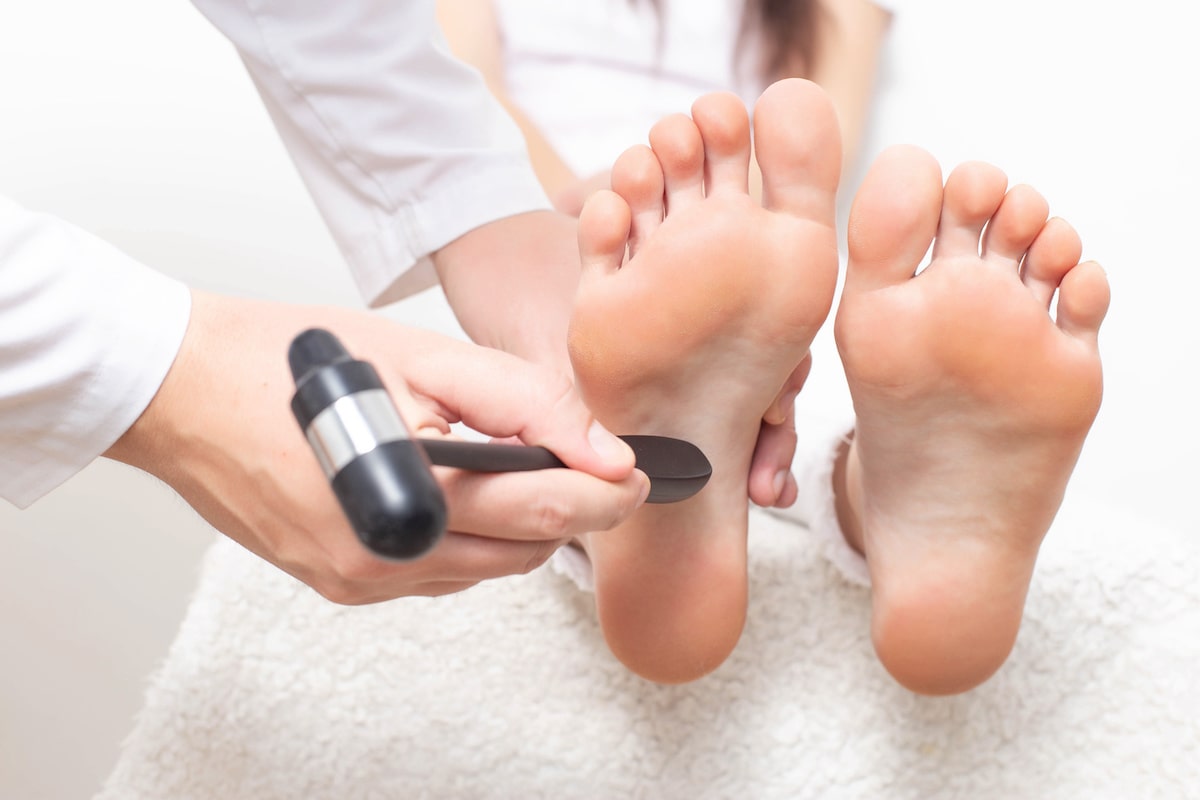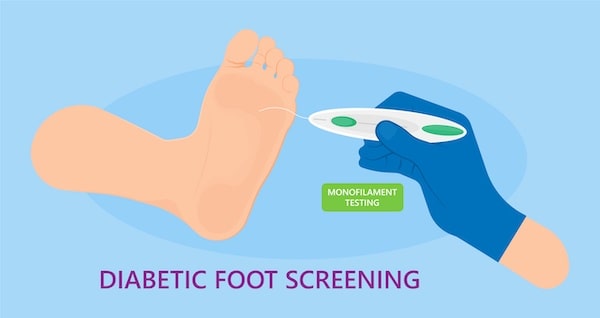Diabetic Foot Exam: What to Expect?

Foot problems are very common among diabetics. They’re mainly caused by two diabetes complications affecting the feet: diabetic peripheral neuropathy (nerve damage) and peripheral artery disease (poor blood circulation). These two conditions considerably raise the risks of foot infections, diabetic foot ulcers, or gangrene which could lead to the amputation of a toe, a foot, or a leg.
To stay away from these serious problems, taking extra care of your feet is essential when living with type 1 or type 2 diabetes. In addition, an annual diabetic foot exam is highly recommended. It helps detect and diagnose diabetes-related foot problems at their earliest stage and avoid severe complications. In the USA, a yearly diabetic foot exam is even covered by Medicare and most medical insurance companies.
But what exactly happens during a diabetes foot examination? Do you have to prepare for it? What kind of tests are run?
What’s a Diabetic Foot Exam?
A diabetic foot exam is a totally risk-free and painless series of medical tests performed by a health professional (normally your GP or a foot specialist known as a podiatrist).
The tests aim at checking for foot problems in people with diabetes, including infections, fungus, injuries, bone deformities, nerve damage, poor blood circulation, as well as early stages of diabetic foot ulcers.
Why do diabetics need foot exams?
Diabetes is dangerous for the feet and people living with either type 1 or type 2 diabetes at are higher risks of developing foot problems. Over time, high blood sugar levels can cause two serious diabetes complications: diabetic peripheral neuropathy (DPN) and peripheral artery disease (PAD). Both these conditions can have serious consequences on the feet.
Diabetic peripheral neuropathy
Diabetic peripheral neuropathy – also called distal symmetric peripheral neuropathy – is a type of nerve damage caused by diabetes in the body’s extremities (feet and hands mostly). Over time, too much sugar in the bloodstream damages the nerves and interfere with their ability to send signals to the brain. Neuropathy can cause extreme pain (often referred to as diabetic foot pain). It can also lead to severe foot and leg problems such as loss of balance, diabetic foot ulcers, gangrene, and lower-limb amputations in the worst cases.
Peripheral artery disease
Peripheral artery disease is another condition often affecting diabetics. A sticky plaque of cholesterol builds up on the arteries’ wall and damages the small vessels. When at an advanced stage, PAD impedes proper blood circulation. There are less oxygen and nutrients delivered to the lower limbs which increases the risks of foot infections, ulcers, and gangrene. It can also cause diabetes swollen feet.
How often should you get a diabetic foot exam?
Diabetics should have a diabetic foot examination conducted by a health professional at least once a year. A yearly foot exam can help detect foot problems you would not be able to notice yourself.
Besides this yearly diabetic foot exam, you should check your feet every day. If you notice anything unusual, immediately call your doctor for advice. Diabetic foot care is essential. Taking good care of your feet at home, wearing diabetic shoes, and managing your blood sugar levels help prevent most diabetic foot problems and their aggravation.
Related article: 10 Diabetic Foot Care Tips for Healthy Feet.
What Happens During a Diabetic Foot Exam?
Diabetic foot exams all follow about the same procedure and series of medical tests. The health professional is looking for two main things: foot or leg problems, and symptoms of diabetic neuropathy or peripheral artery disease. A diabetic foot exam is 100% pain-free. You do not need to prepare for it. All you will be asked to do is to take off your shoes and socks, and answer a few questions. Here is what you can expect to happen during your next diabetic foot exam:
Questions about health and diabetes management
Your healthcare provider will most likely begin your diabetic foot examination with a series of questions to assess your general health and diabetes management. Do not hesitate to mention any previous problems you’ve had with your feet even if they happened years ago.
Dermatological examination of your feet
The doctor will visually inspect your feet to search for any skin or toenail problems such as dry or cracked skin, fungal infections, wounds, blisters, calluses, corns, or signs of diabetic foot ulcers.
Monofilament test
During the monofilament test – also called the Semmes-Weinstein monofilament test – your GP or podiatrist will brush a soft nylon fiber over your feet to test their sensibility to touch. It’s a neurological test to diagnose neuropathy in the feet. If you cannot feel anything, it’s an indication of nerve damage.

Tuning fork test
Pinprick test
Ankle jerk reflex test
The doctor will gently tap on your feet with a small mallet or a rubber hammer to check your ankles’ reflexes. This is called the ankle jerk reflex – or Achille reflex. The absence of reflex is abnormal and may indicate neurological disorders caused by diabetes (neuropathy).
Musculoskeletal assessment
Doppler ultrasounds
Shoe fitting verification
Diabetic Foot Exam Video
Here’s a very informative video by DIABETES UK about what to expect when having a diabetic foot exam. You can most probably expect the same wherever you live in the World:

Medical Insurances and Diabetic Foot Exams Coverage
If you’ve been diagnosed with diabetes, and even more so with peripheral neuropathy, chances are your national or private medical insurance covers the cost of one diabetic foot exam per year.
Think about it this way: your diabetic foot exam will cost your insurance company a few dozens of dollars vs thousands of dollars if you get serious foot problems.
It’s prevention for yourself as much as for your insurance company!
Does Medicare cover diabetic foot exams?
In the USA, Medicare covers most of diabetes medical costs. It is expressly stated on Medicare.gov that Medicare “covers foot exams once a year if you have diabetic peripheral neuropathy and loss of protective sensations, as long as you haven’t seen a foot care professional for another reason between visits.”
Does NHS UK cover diabetic foot exams?
For UK residents, the National Health Services (NHS) entitles everyone with diabetes to at least one annual foot check. It’s free.